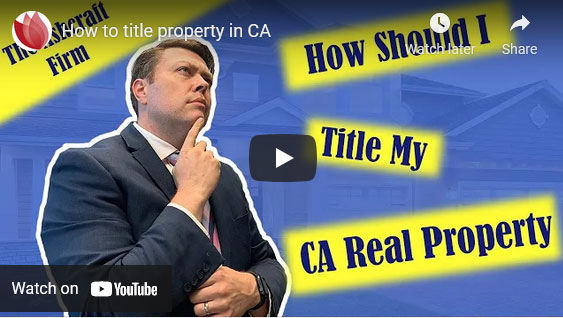
DEBT CONSOLIDATION CAN GIVE YOU A NASTY SURPRISE
October 10, 2020
How to Title My California Real Property
May 10, 2021
As a general rule in California, there is no need to reaffirm a mortgage. Reaffirmations of mortgages are not even mentioned in the Bankruptcy Code. A reaffirmation is a contract signed during a bankruptcy to continue to pay secured debt attached to personal property. A debtor would reaffirm a debt in order to retain the property securing the debt. The Code provides the possibility for debtors to reaffirm debts at 11 USC 521(a)(6). That Code section only mentions reaffirmation of debts secured by “personal property,” not debts secured by real property. “Real property” is bare land plus anything that is permanently attached to that land, such as a house. Personal property is everything else: shoes, mobile homes, cars, refrigerators, and anything else you can list.
Since the Code section dealing with reaffirmations only refers to personal property, the question occasionally arises as to whether it is necessary (or even possible) to reaffirm debts secured by real property. The relevant code section (11 USC 521(a)(6) provides that a debtor may not retain personal property unless the debtor enters into a reaffirmation agreement or “redeems” the personal property. A redemption is a lump sum payment the creditor agrees to accept as payment in full; thereby allowing the debtor to keep the secured property.
Most attorneys in California tell their clients that a reaffirmation of real property is not necessary. That advice is correct, but it doesn’t cover the entire topic. Unfortunately, lenders do not seem to distinguish between real and personal property for purposes of reaffirmation. Some lenders refuse to permit loan modifications on mortgages that were not reaffirmed in a prior bankruptcy. That practice is an improper application of the law, but it causes a lot of headaches for post-bankruptcy clients.
Even though the Bankruptcy Code provides only for reaffirmation of personal property, most judges will allow reaffirmation of a mortgage. There is one situation where it may be a good idea to reaffirm a mortgage. Mortgage payments made after a bankruptcy are not reported on the debtor’s credit report unless the debtor has reaffirmed the mortgage. If the debtor wants payments reported on his credit report, a reaffirmation is necessary. Mortgages that were not reaffirmed during bankruptcy are reported as “discharged in bankruptcy.” This status is attached to all non-reaffirmed mortgages even if the debtor retains the home and makes every post-bankruptcy payment on time.
California is an “anti-deficiency” balance state. That means that a debtor cannot be held liable for the deficiency balance on his residential first mortgage if the property is sold at foreclosure for less than enough to pay off the first mortgage. A mortgage discharged in bankruptcy releases all personal liability on the part of the homeowner. Signing a reaffirmation re-attaches personal liability to the homeowner, but this is a change without substance.
Generally, reaffirming a mortgage in California does not attach new obligations to the mortgage. A debtor who plans to retain real property after a bankruptcy, must make the mortgage payments whether or not the mortgage has been reaffirmed. The main thing a reaffirmation affects is whether post-bankruptcy mortgage payments are reported on the credit report. If the homeowner wants his mortgage payments reported post-bankruptcy, then a mortgage reaffirmation provides the avenue to do so.
Ms. Medrano is an experienced bankruptcy attorney practicing In Southern California. She is a graduate of Cornell University and Cal Western School of Law. She is licensed in California, New York and the District of Columbia.


